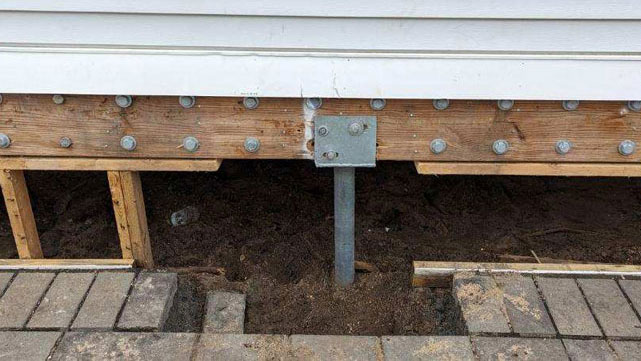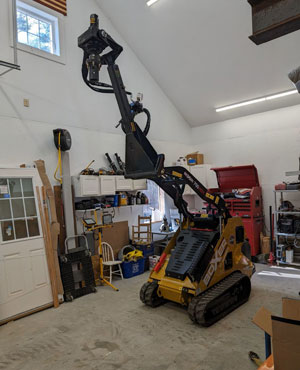A recent job in New Hampshire illustrates how an innovation in installation equipment has provided helical contractors with another option when faced with access challenges. Portable handheld equipment is an option in some situations, but it comes with limitations in torque (and ultimate capacity), downward pressure, and is slow and labor intensive. Pro Dig USA’s low-profile bracket proved to be the answer on Cable Avenue in Salisbury Beach, New Hampshire for Danbro Installer Norm Carpentier (Carpentier Construction) and his cost-conscious client.
 The owner of a 24′ X 40′ prefab modular building wanted to add a second story to maximize water views in a beach town. However, the structure lacked a footer and was supported on Sono tubes above grade. The structural engineer, THC, required a deep foundation system in this sandy soil environment to reach a suitable bearing stratum, deal with scouring, and support the additional load. Lifting the small home would have provided ample room to get in under the structure to install the piles, but it was costly.
The owner of a 24′ X 40′ prefab modular building wanted to add a second story to maximize water views in a beach town. However, the structure lacked a footer and was supported on Sono tubes above grade. The structural engineer, THC, required a deep foundation system in this sandy soil environment to reach a suitable bearing stratum, deal with scouring, and support the additional load. Lifting the small home would have provided ample room to get in under the structure to install the piles, but it was costly.
The building was 2′ above grade with little room to get the piles up under the structure. Norm Carpentier had recently purchased the Pro Dig low-profile bracket assembly and, together with an extended boom, thought he had the answer to this conundrum. Norm installed the 5′ lead section at a slight angle, as you would in an underpinning application, using extensions to advance the lead, and then used the long boom to muscle the lead up under the support beam under the house. The soil was sand for approximately 15’ and terminated in shale at around 20’. The engineer insisted the wooden beam be further reinforced with a continuous 3/8″ thick, 10″ high steel plate behind the beam, installed with a Mag drill and attached with 2 bolts at every 8″. The steel plate sections were cumbersome to work with and weighed 250 pounds apiece. Walkway beam seat brackets slid inside the IDEAL 2 7/8” pipe piles and were bolted to the reinforced beams, completing the process.
Click here to read Cable Avenue Case History.
Danbro, confronted with similar site challenges on other projects, had reached out to Pro Dig and provided a rough sketch of what was needed to overcome the mobilization issues faced in similar circumstances on a couple of earlier projects. “We get requests like these a lot,” stated Mike Charlton from Pro Dig, “usually for overhead, but in this instance, the reach was also at issue and Danbro pitched in with a rough sketch of what was needed. A 10’ long boom with a smaller 7K drive with only 18” to the output flange eliminated the Kelly bar, saved space, and reduced the weight,” he summarized. Typically, Mike continued, “it only takes two to three days for our engineer to generate drawings and about one to two weeks for us to produce special orders like this one.”
Click here to access the Pro Dig USA website.
Recently, I have written about several other projects where Danbro Installers Steve Vaspoli (Blue Water Condos) and Fred Wilson (Lake Drive) have utilized the Gimbal (low-profile bracket) drive string assembly to mitigate access challenges, including both head room and reach (with the extended boom). The popularity of the Gimbal bracket should only grow as access and its companion, mobilization, will always present challenges on helical projects.
Click here to read Lake Drive Case History.
Click here to read Blue Water Condominium Phase II Case History.






No comments yet.